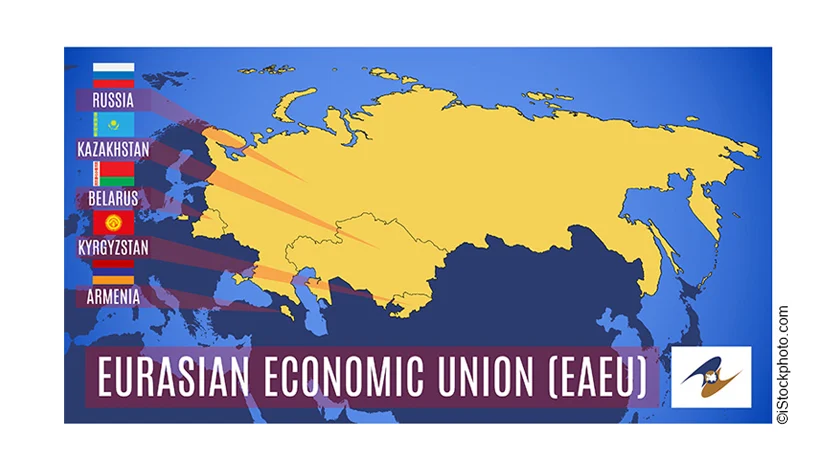Published
1 day agoon
By
Ugdiplomat
The Eurasian Economic Union (EAEU) is a significant international integration project in the post-Soviet space, the evolution of which reflects the complex search for optimal models of cooperation after the dissolution of the USSR. The origins of the EAEU are sought in the desire of a number of states of the former Soviet Union to preserve and develop economic ties that were lost in the early 1990s.
Initial attempts at reintegration within the framework of the Commonwealth of Independent States (CIS) proved ineffective, which stimulated the transition to deeper forms of cooperation. The key stage on this path was the formation of the Customs Union of Russia, Belarus, and Kazakhstan, which became fully operational on January 1, 2010. This step provided for the creation of a single customs territory, the abolition of customs duties in mutual trade, and the application of a single customs tariff in relation to third countries.
The next step was the creation of the Common Economic Zone Agreement (CEZ) on January 1, 2012, which expanded integration beyond the customs sphere. The CEZ concept was based on the principle of “four freedoms”: the free movement of goods, services, capital, and labor. This stage required significant harmonization of national legislation and the creation of supranational regulatory mechanisms, the main of which was the Eurasian Economic Commission (EEC), the single permanent regulatory body of the Eurasian Economic Union.
The main task of the EEC is to ensure the conditions for the functioning and development of the Union, to develop proposals for the further development of integration. The effectiveness of the Commission and its ability to find compromise solutions that take into account the interests of all parties remain critical to the success of the integration project.
The logical conclusion of this evolutionary process was the signing of the Treaty on the Eurasian Economic Union in Astana on May 29, 2014, which entered into force on January 1, 2015. The initial participants were Russia, Belarus, and Kazakhstan. Subsequently, Armenia (January 2, 2015) and Kyrgyzstan (August 12, 2015) joined the EAEU. At the same time, four more countries – Moldova, Cuba, Uzbekistan, and Iran – became observer states.
The EAEU Treaty codified the agreements reached earlier and laid the legal foundation for further deepening integration, coordinating economic policy, and forming a common market.
As noted earlier, the creation of the EAEU marked the transition to a qualitatively new level of integration cooperation. The following years were devoted to both the implementation of the provisions of the EAEU Treaty and the adaptation of the Union to changing global and regional conditions.
An important aspect of this process was the adoption of strategic documents defining long-term development guidelines, in particular, the “Main Directions of International Activities of the EAEU” and “Strategic Directions for Developing the Eurasian Economic Integration until 2025.” These documents emphasize the need to increase the competitiveness of the member countries’ economies, stimulate innovative development, and strengthen the Union’s position in the international arena.
The consistent development of the EAEU is determined by the Declaration on the Further Development of Economic Processes within the Framework of the Eurasian Economic Union until 2030 and for the period up to 2045, which was adopted on the initiative of Russia and was named the “Eurasian Economic Path.”
The current stage of the EAEU’s development is characterized by both the desire for the full realization of declared freedoms and the elimination of remaining barriers, as well as the search for new areas of cooperation, including the digital agenda, the formation of common energy markets, and the development of transport infrastructure.
Despite the successes achieved, the EAEU faces a number of challenges due to differences in the economic models of the participating countries, the influence of external factors, and the need to further harmonize national interests with the goals of supranational development. Nevertheless, the EAEU remains an important factor in the economic growth and geopolitical positioning of its member states on the Eurasian continent.
By the end of the first decade of its existence, the EAEU had reached significant quantitative indicators, and the combined GDP of the Union’s countries, with a total population of 185.5 million people, had grown from 1.6 trillion to 2.5 trillion US dollars. Trade turnover with third countries increased by 60% from 579 billion up to 923 billion US dollars. The volume of mutual trade has doubled.
In parallel with the removal of internal barriers, the EAEU is actively developing foreign economic relations. One of the key directions is to build a system of preferential trade agreements with third countries and integration associations. Free trade agreements with Vietnam, Singapore, Serbia, and Iran are examples of such policies.
Negotiations and consultations are underway with a number of other states, including Egypt, India, and Indonesia. This activity vector is aimed at diversifying foreign economic relations, expanding sales markets for goods produced in the EAEU, and attracting foreign investment. The Union’s supranational body, the Eurasian Economic Commission, has more than 80 memorandums of cooperation with third countries, organisations, and integration associations.
The integration processes within the EAEU with the Chinese “One Belt, One Road” initiative seem promising, which opens up opportunities for the implementation of large infrastructure projects and the development of transcontinental transport corridors. Cooperation with the CIS, the Shanghai Cooperation Organization (SCO), BRICS, and the Association of Southeast Asian Nations (ASEAN) is being strengthened.
The EAEU is interested in stimulating scientific and technical cooperation, developing the digital agenda, supporting high-tech industries, and creating favorable conditions for human capital. The successful implementation of these tasks will allow the EAEU not only to strengthen its position as a significant economic center, but also to ensure sustainable development and improve the well-being of citizens of the participating countries.
The author is the Ambassador Extraordinary and Plenipotentiary of the Russian Federation to the Republic of Uganda and the Republic of South Sudan (concurrently accredited), H.E. Vladlen Semivolos.
